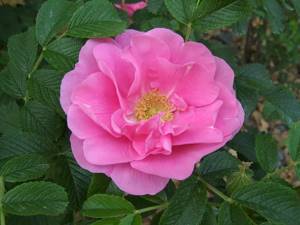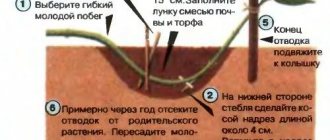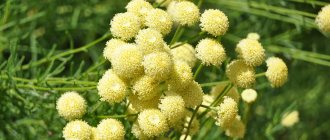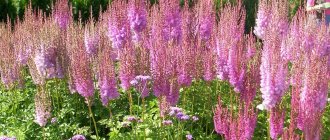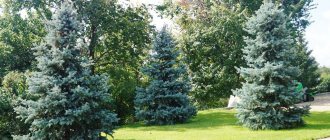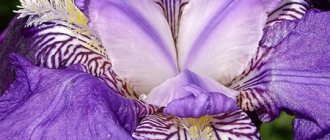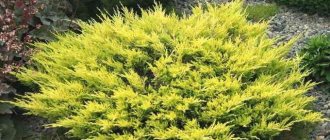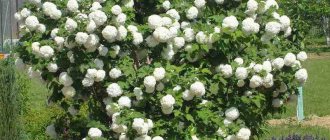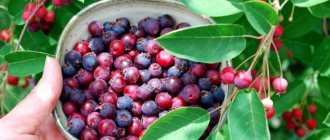0 1196
Russian gardeners increasingly began to plant wrinkled-looking roses on their plots. This phenomenon can be explained by the unpretentiousness of care and ease of planting of this plant. It is classified as a member of the rose hips and rose family. Miniature flowers are famous for their aroma with sweet notes, and the fruits for their beneficial properties. However, it is quite difficult to find this copy on the market.
Description of the plant
Wrinkled rose or rose hip, rugosa is the name of the same plant, which belongs to the Rosaceae family. It grows wild in Northern China, Japan, and the Far East. Most often, this variety of rose can be found on sea coasts and coastal meadows. Often found in nature reserves and protected areas.
Externally, the plant is a spreading shrub up to 2.5 meters high. The leaves have a wrinkled structure and gray-green pubescence at the bottom of the leaf blade. Their length can reach up to 22 cm in length. Flowering is possible on both young and last year's shoots, on which there are numerous thorns curved down.
The flowers are solitary or collected in inflorescences of 3-8 pieces. The fragrant buds are very large, colored in a variety of shades depending on the variety. Flowering is abundant and can last all summer, starting in June. Some hybrids can bloom twice in one season. At the end of summer, large orange-red fruits with a diameter of up to 2.5 cm are formed. Wrinkled rose is winter-hardy, so it is often found in areas with cold climates.
Types, varieties
Rose rugosa is the only species in its group, but thanks to the efforts of breeders, many varieties have been developed. They differ in the color and texture of the buds, the size of the bush, and the way they are grown. Below are the most popular varieties for growing in Russia.
Grootendorst
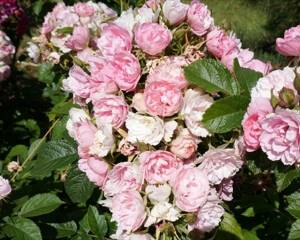
This is a large varietal group, represented by several varieties of park roses. Bred by a Belgian breeder in a nursery in 1918, later varieties were obtained that differed in the color of their buds. The height of the bush does not exceed 1.5 m, the plant is always erect. The leaves are typical of all wrinkled roses.
Of interest is the shape of the flowers, after which the variety is often called the carnation rose. The flowers are solitary, but more often collected in small carnation inflorescences of 5-20 pieces. Color varies depending on the variety, with pink, white and crimson petals being more common. Rose Grootendorst tolerates winter well, but in severe frosts it requires shelter.
Alba
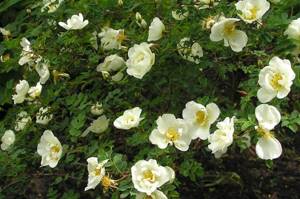
Hybrid form of European selection. The variety is represented by an upright growing bush up to 2 m high. Flowering is possible only once per season, lasting up to 30 days. The bush does not produce fruit. The flowers are large, growing up to 5-8 cm in diameter. The color of the petals is white or pink-white. It is characterized by frost resistance, resistance to diseases and pests.
Hansa
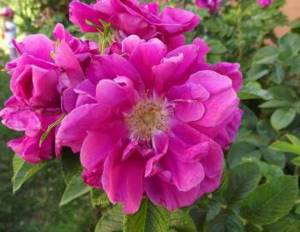
A popular variety, often used to create hedges. It is a low shrub growing up to 2 m in height. The buds are elongated, the petals are double, painted lilac with a golden center. Flowering is possible all summer until frost. The fruits resemble small red-orange tomatoes.
Queen of the North
It is characterized by high frost resistance and stability, as well as a fast growth rate of the bush. The plant can reach a height of up to 2 m, but in colder regions the rose is usually more compact. Flowering continues almost the entire season from June to early September. The flowers are large, growing up to 12 cm in diameter. The color of the terry petals is pink or white-pink. The fruits contain a large number of useful elements, due to which they can be used to make jams and preserves.
Rubra
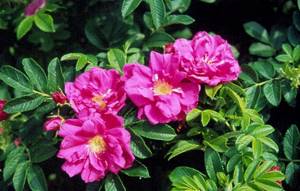
The rose of this variety is a large spreading shrub that grows up to 2.5 m. Flowering is possible all summer; in favorable conditions there is a chance of re-formation of buds. The flowers are large, there are specimens up to 12 cm in diameter. The petals can be colored in various shades of pink. At the end of summer, large orange-red fruits are formed. The variety is unpretentious and easy to care for. Often used to create hedges and planting in mixborders.
Selection of location and conditions of detention
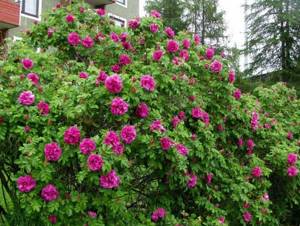
In general, the wrinkled rose differs from other members of the family in its unpretentiousness and adaptability to external conditions. The plant is often planted to create a hedge, so in order to achieve active growth and abundant flowering, you should wisely choose a place for growing.
Lighting and location
Rosa rugosa is a light-loving plant. For planting, it is best to choose a well-lit area with protection from the wind. The optimal solution is a southern slope or a flat area next to a building or a fence. Often, wrinkled roses are planted as part of a multi-species mixborder; in this case, it is not recommended to place the plant under the shade of large trees. If you follow the rules of care, the shrub is characterized by active growth, so you need to plan the place wisely, especially when creating a hedge.
Temperature
Almost all varieties of wrinkled rose hips are unpretentious to temperature conditions. The plant grows best in the range of 16-22°C, but can even tolerate severe frosts down to -40°C. In the first two years of life, it is recommended to protect young plants from sudden changes in temperature, for example, when there is a threat of night frosts in spring and autumn.
In addition, when growing in the northern regions, it is recommended to cover the bush for the winter, since sudden changes in temperature can lead to the death of the bush and young shoots. In the southern and central regions of Russia, there is no need to protect wrinkled roses.
Air and humidity
The plant prefers moderate humidity; with increasing moisture levels in the soil, infectious diseases of the root system may develop. Therefore, during the rainy season, it is recommended to reduce the amount of watering; additional procedures, for example, spraying, are not carried out.
Wrinkled roses do not tolerate drafts well, so you need to choose a planting location wisely. For adult bushes, support must be installed to avoid breaking branches and stems.
Priming
It is advisable to plant garden roses of this group in fertile and well-aerated soil. It is desirable that the substrate retains water well, but does not accumulate it in large quantities. The best option is sandy or loamy areas with a neutral acidity level. When growing in a dense substrate, before planting, it is advisable to add river sand at the rate of 10 kg per 1 m2 to enhance looseness and aeration.
Growing and caring for the Pink Grotendorst variety
Rose Pink Grotendorst is not demanding in care. The crop can be planted in a sunny or slightly shaded place. The plant will bloom in rainy and humid weather, so it is not necessary to specifically protect the bush from precipitation.
For the Pink Grotendorst rose, loam or sandy loam is suitable. Rose hips survive in dense soil, but it is recommended to add humus to the soil before planting. Planting can be done in spring or autumn.
Autumn planting is permissible from September to mid-October; later the plant may not have time to take root. For the seedling, you need to prepare a planting hole 60 cm deep. It is necessary to lay a drainage layer and a soil mixture of manure, peat, garden soil and sand on the bottom. Before planting, it is recommended to treat the seedling by removing weak and dry shoots.
Rose Pink Grotendorst does not require frequent watering. The bush can be watered once every two weeks. An adult plant needs about 20 liters of water. It is recommended to loosen the rose periodically.
It is important to regularly remove large weeds from the soil near the bush. In spring it is necessary to apply nitrogen fertilizers. Manure, mullein or bird droppings can be used as fertilizer; commercial bulk fertilizers are suitable. It is recommended to apply phosphorus-potassium fertilizers in the summer.
The rosehip bush needs to be pruned regularly. It is necessary to remove overgrown branches, cut off old, dry and damaged shoots. Without pruning, the bush will look shapeless and sloppy.
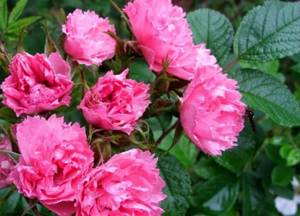
Rejuvenating and sanitary pruning should be carried out in the spring. In the fall, it is necessary to shorten the bush and cut off shoots damaged by insects. The variety Pink Grotendorst is resistant to frost; in regions with warm winters the bush survives without shelter. If the winter is frosty and with little snow, it is recommended to hill up the tree trunk with peat so that the roots do not freeze.
Preparing for landing
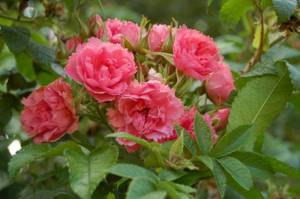
Before planting, you need to prepare not only the seedlings, but also the soil. To do this, 2-3 days before the start of work, you should thoroughly dig up the area to the depth of the spade bayonet. Fertilizers must be added. Plants respond well to organic matter, so the addition of these compounds is mandatory. For example, peat or humus is used at the rate of 8-10 kg per meter. In addition, it is recommended to add inorganic compounds - 10 g of superphosphate, 50 g of potassium salt per 1 m2.
Seedlings should be inspected for deformations and damage to the stem and roots. The root system should be healthy and slightly moist. A few hours before planting, you need to soak the seedlings in a solution of a growth stimulator, for example, Kornevin or Epine. It is advisable to carry out the procedure itself in the morning or afternoon, so that during the first half of the day the roots adapt to the soil temperature.
Planting process
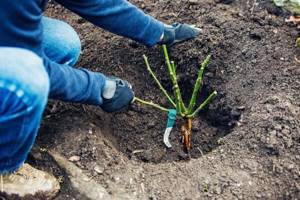
It is permissible to plant wrinkled roses both in autumn and spring until new buds appear. The optimal length between plants is 1.5 meters. To form a hedge, planting density should be maintained at the rate of 50-100 cm between plants, 50-80 cm between rows. Seedlings are planted in individual holes, taking care not to damage the root system. During planting, you need to add a little wood ash to the bottom of the hole to prevent fungal diseases.
Immediately after planting roses, they need to be cut to 1/3 of the length of the shoots, watered abundantly and mulched. Already at this stage it is worth installing supports to reduce the harmful effects of wind. When planting in autumn, young plants are covered with spruce branches or agrofibre to avoid hypothermia.
General description of rose wrinkled Alba
Rose rugose or rugosa is one of the most decorative species, growing wild in Japan, China and the Far East. This plant got its name from the characteristic wrinkling of its leaf blades. The common rugosa has purple-red flowers, while the Alba form has white flowers, sometimes with a pinkish tint. The word “alba” itself is translated from Latin as “white, white.”
Main characteristics of Rosa rugosa f. alba look like this:
| Evaluation parameter | Characteristic |
| Color | White |
| Number of flowers per stem | 1-5 |
| Aroma | ❀❀❀ |
| Flower size | 6-10 cm |
| Height | 150-200 cm |
| Width | 180 cm |
| Growing area (USDA) | Zone II (Transbaikalia, Komi Republic, Eastern and Central Siberia) |
| Winter hardiness | ❄❄❄ |
| Powdery mildew resistance | ★★★ |
| Black spot resistance | ★★★ |
| Rain resistance | ☂☂ |
| Flowering period | ☀☀☀ (continuously blooming) |
| Boarding time | April or end of October |
The life form of Rugosa Alba is a branched shrub with erect, thorny shoots of gray color. The flower of this species is simple, five-petaled, but large and very fragrant.
Rugosa Alba flowers hold up well to rain, making the plant suitable for growing in humid, rainy climates.
The main advantages of Rosa rugosa f. alba are as follows:
- exceptional frost and drought resistance;
- easy adaptation to changing conditions;
- low demands on soils;
- long-lasting abundant flowering;
- decorativeness and high nutritional value of fruits;
- ability to quickly recover after pruning or mechanical damage;
- easy adaptation to growing in an urban environment.
The relative disadvantages of the white wrinkled rose include its tendency to grow and take over territory. Therefore, this plant is not suitable for growing in small areas. In a limited area, it will require constant monitoring of the growth.
Tip #1. The white wrinkled rose, like other vigorously growing rose species, can be used to create impenetrable thorny hedges. It is also excellent for strengthening slopes and slopes.
Rugosa Alba does not require special attention from the grower, but is responsive to care.
Reviews from owners of Rosa rugosa f. alba
Rose wrinkled Alba is one of the most popular plants among gardeners living in cold and even polar regions (
Rules for caring for and growing in the garden
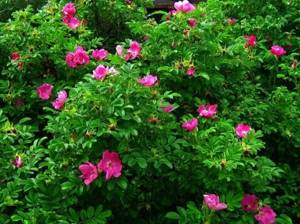
When grown in garden conditions, wrinkled roses are very easy to care for. They do not require abundant watering, and fertilizers need to be applied less frequently than other flowering plants. Let's look at the most important points of caring for rugosa.
Watering
Like other representatives of the Rosaceae family, wrinkled rosehip is a moisture-loving plant. In this case, it is important to observe the irrigation regime and the specifics of water application. Water the shrub only at the root, avoiding liquid getting on the buds and leaf blades. During the active growing season, the plant is watered no more than twice a week at the rate of 10-12 liters per bush. During the rainy season, watering should be reduced to a minimum or stopped altogether. They stop watering the rose completely, starting from the beginning of September, so as not to influence the process of formation of new shoots.
Top dressing
Roses respond best to organic matter, so at least twice a season it is worth adding humus or mullein solution at the root. The procedure is carried out in spring and autumn after scheduled pruning. Before the start of the growing season, the plant begins to need magnesium and iron, so it is recommended to use complex formulations containing all the necessary elements.
During the season, liquid multi-component fertilizers are used as top dressing. The procedure is best carried out immediately after the next watering. When growth and budding slow, you can use special compositions for garden roses, which can be easily found in any specialized store.
Loosening, mulching
The loosening procedure is carried out only in the first three years of plant growth, when the roots of the bush are actively forming. Loosening is carried out 2-3 times per season, starting in early spring. During this, you need to very carefully process the soil along the entire diameter of the bush, trying not to damage the root system.
Mulching helps to avoid the active growth of weeds and improve the process of water retention on the top layer of soil. It is best to use sawdust or dry leaves as mulch; the procedure is carried out up to twice a season after pruning, which simplifies access to the lower part of the bush.
Pinching, pinching, pruning
Pruning the bush is an integral part of working with garden wrinkled roses. The first shaping is carried out no earlier than 2 years from the moment of planting; it is only of a sanitary nature. As a rule, pruning is carried out at the end of April before the formation of young shoots.
You cannot completely shorten all parts of the plant; only deformed, diseased and old branches need to be removed. It is advisable to cut the shoots to a length of up to 6 growth buds, so as not to disrupt the flowering process. For rejuvenation, complete shaping is carried out, removing all parts of the bush to a length of 10-15 cm from the top layer of soil.
Wrinkled rose hips respond well to pruning, so annual decorative shaping is used to create a hedge. To do this, the bush is given the necessary shape, leaving some young and old branches.
Transfer
Like other types of garden roses, rugosa can live in one place for up to 20 years. The plant needs to be replanted if the bush becomes infected and the intensity of flowering and growth decreases. The procedure is carried out only in the fall, immediately after flowering and fruit formation are complete.
First, the plant needs to be cut almost to the very root, and then, together with a lump of earth, transplanted to a previously prepared area. Immediately after this, you need to apply organic fertilizer in liquid form, water the soil generously and cover it for the winter.
Care
- Watering. During watering, water should not get on the leaf blades and flowers. During the active growth phase, the procedure is carried out twice a week. One bush needs 12 liters of liquid.
- Feeding. Organic fertilizers should be applied twice each season. Humus and mullein are used in autumn and spring. When the growing season begins, you need to add magnesium and iron. To improve immunity and longer flowering, it is recommended to use fertilizers with a broad composition.
- Mulching, loosening. During the first 3 years of life, you should carefully loosen the soil around the plant. Mulching helps fight weeds and maintains the desired level of soil moisture.
- Trimming. A couple of years after planting in April, it is necessary to free the rose from dry, diseased branches. This must be done before new shoots appear. Hedges are pruned every year.
- Transfer. A rose can grow without changing its place for 20 years. It should be replanted if an infection appears or the flowering rate has dropped. This operation must be carried out after the development of the fruit. The plant must be cut at the root, removed from the soil with an earthen lump and transferred to a new trench. Then liquid organic matter is used and a shelter is organized for the winter.
Wintering
Wrinkled roses best tolerate even severe frosts, so they are often planted as an ornamental garden crop in cold regions. Additional shelter for the winter is required only when growing shrubs in the north, for plants up to 3 years of growth, and also after the next transplant to a new location.
When preparing for winter, you need to remove all the buds from the plant and remove fallen leaves and fruits, and then properly hill up the soil to a depth of 20 cm. It is very important to prune and mulch the trunk part of the bush. The upper part of the plant is tightly tied to a support, wrapped in craft paper or fabric, and then covered with spruce branches. You can remove the shelter in the spring, when there is no likelihood of severe night frosts.
Nuances and tips for growing
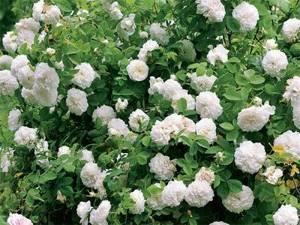
Wrinkled roses are the most successful option for landscaping in regions with unfavorable climatic conditions. There are a number of subtleties of growing that will simplify working with shrubs:
- Rugosa rose is highly resistant to diseases and pests, but as a preventive measure it is recommended to treat the planting with insecticides and fungicides at least once a season. It is best to use complex chemical compounds that are most effective;
- To increase the planting volume, wrinkled roses can not only be propagated by cuttings, but also using self-collected fruit seeds. They have a high level of germination and are stored for a long time;
- if the bush’s growth rate has significantly decreased and flowering is less abundant, it is recommended to carry out sanitary pruning or transplant the plant to a new location;
- When purchasing planting material, you should pay attention to the photo and annotation on the packaging. Often less decorative varieties of rose hips are sold under varieties of wrinkled roses;
- large and healthy fruits can be used to create preparations, jams and even medicinal infusions.
Wrinkled rose is a unique ornamental plant. It has high resistance, immunity and rapid growth. Due to its attractive appearance, the shrub is often used in landscape design to create multi-species compositions and hedges. The plant can stay in one place for a long time and delight with abundant flowering even with little care.
Landing rules
Planting a wrinkled rose does not cause any difficulties even for beginners and inexperienced gardeners. When planting this ornamental crop, you should pay attention to the following simple rules:
- rose rugosa belongs to the category of crops that are completely undemanding in terms of soil composition and nutritional value;
- you can grow the plant in areas with slight salinity and prone to drought, but it is best to allocate for planting areas protected from the wind and well-lit in a southern and western direction;
- It is best to plant this type of rose in early spring, even before active bud bloom;
- if there is a need to create a high decorative hedge, then planting Rósa rugosa seedlings is carried out according to the scheme 0.6 × 0.6 m or 0.8 × 0.8 m;
- Group plantings of rugosa roses with junipers or spirea are carried out with a mandatory distance of one and a half meters.
Immediately after planting, the plants should be watered abundantly and, during the first two weeks of rooting, shade should be provided from the scorching sun.
